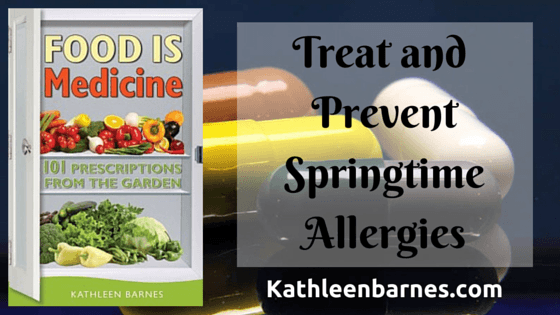It’s that time of year . . . when the trees and grasses are blooming. For many of us, it can be a time of miserable head congestion, sinus headaches, sneezing and coughing.
These excerpts from my book, Food Is Medicine: 101 Prescriptions from the Garden offer some food-based ways to prevent and treat springtime allergies and asthma:
ALLERGIES
Your Garden RX: garlic, onions, apples, chamomile
Allergies are your body’s response to what it perceives as an invader. With allergies, your immune system reacts or overreacts to a stimulus whether it’s triggered by a particular food (eggs, corn and peanuts are common food allergens), penicillin, pollen, dust, bee stings, mold, pet dander or latex or some similar substance—even though in reality that stimulus may not be at all threatening to you.
When this happens, your body releases histamine, a chemical that can cause a wide variety of symptoms ranging from hives and frantic itching to sneezing, sinus congestion, swelling, and, in serious cases of food and drug allergies, lowered blood pressure, unconsciousness and even death.
Your Garden to the Rescue
Garlic and onions to the rescue, again! Add apples in the same category because all three of these common garden foods contain a flavonoid called quercetin, which controls the release of histamines during an allergic reaction. Quercetin also reduces the production of leukotrienes, compounds that cause even more severe inflammation than histamines do.
Chamomile is a daisy-like herb whose flowers make a calming and soothing tea. , Chamomile is a source of natural antihistamines and quercetin. It may also be helpful in an anaphylactic (severe allergic reaction) episode, but it shouldn’t ever take the place of a visit to the emergency room if you know you are severely allergic to peanuts, bee stings, or other allergens and have been exposed to them. Drinking a cup or two of chamomile tea daily can help suppress the histaminic reaction, and over time, may make your allergic reactions less irritating or even help them disappear.
RX from Outside Your Garden
If you’re a beekeeper, your own honey may also be helpful. Your allergic reactions may be caused by local pollens, so the honey from bees collecting those pollens may act as the antidote to the perceived immune system threat caused by the allergens. If you don’t keep bees, try to find honey made from local pollens produced not more than a few miles from your home.
ASTHMA (Also see Allergies)
Your Garden RX: strawberries, broccoli, tomatoes, onions, garlic, horseradish, spinach, borage, dill
Acute asthma attacks can be life threatening, so please don’t stop the prescription medications your doctor has given you and don’t fail to go to the emergency room immediately when an attack occurs. However, over time you may find your need for inhalers will diminish with the help of foods from your garden. Asthma causes inflammation of the airways (bronchial tubes) making it hard to breathe and causing chronic cough, wheezing and shortness of breath. It can also cause a buildup of mucus in the bronchial tubes, making it harder and harder to breathe. The onset of a full-blown attack when the bronchial tubes spasm is truly frightening and, without emergency care, can be fatal.
Your Garden to the Rescue
Vitamin C is a natural antihistamine, meaning it stops the extreme inflammatory response that triggers the wheezing and runny nose, so eating all foods high in vitamin C will be helpful, including strawberries, broccoli, tomatoes, and citrus fruits, if you’re lucky enough to live in a place where you can grow them. Some research also suggests that eating lots of vitamin C-rich foods can reduce the severity of asthma attacks. Note: If you’re eating citrus fruits, try squeezing the peels and inhaling the aroma. A substance called limonene, which is found in the citrus peel, helps soothe the airways. You can also eat the peels, but wash them well to be sure to remove any contaminants that might be present.
Onions and garlic are rich sources of two major anti-inflammatory and anti-asthmatic compounds, quercetin and cepaene, that can help soothe irritated airways.
If you’ve ever taken a big breath of horseradish, wasabi, cayenne, or other spicy foods, you’ve probably noticed that your airways immediately open up if you’ve been experiencing any stuffiness. This holds true for asthma as well. I don’t recommend regularly inhaling the fumes of these pungent foods, but adding them to salads, or better yet to hot soups and stews, will have the same effect.
Leafy greens like spinach are good sources of vitamin E, which helps your body release soothing compounds to relax muscles in the lungs.
Borage is a natural decongestant and expectorant, so it can help reduce the mucus in the airways, and dill is a traditional relaxant for the bronchial system.







